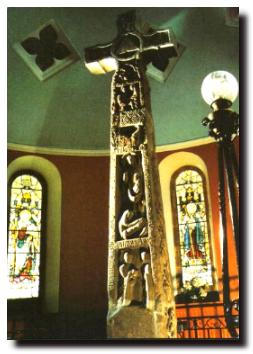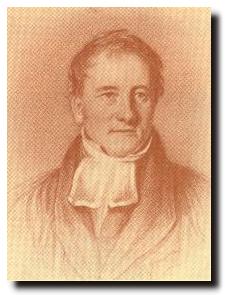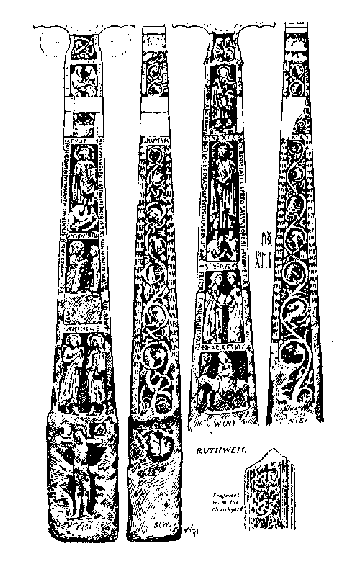Origins
 The Ruthwell Cross is one of the oldest Preaching Crosses in Europe, and was first raised on the Solway towards the end of the 7th century. It is thought to have been created by monks of the Columban (or Scotic) Church, as a protest against the Church of Rome. The Roman Church had sought to achieve supremacy in England by expelling the evangelical Church of Iona from Northumbria in the North of England, an area geographically close to the far south-west of Scotland where the cross was sited.
The Ruthwell Cross is one of the oldest Preaching Crosses in Europe, and was first raised on the Solway towards the end of the 7th century. It is thought to have been created by monks of the Columban (or Scotic) Church, as a protest against the Church of Rome. The Roman Church had sought to achieve supremacy in England by expelling the evangelical Church of Iona from Northumbria in the North of England, an area geographically close to the far south-west of Scotland where the cross was sited.
The cross is eighteen feet high, decorated with sacred carvings depicting scenes from the New Testament, and with ancient Runic letters. It was probably created in 664AD, after the Synod of Whitby. At that meeting of church-men, the presbyterian Colman - Bishop of Lindisfarne, found it impossible to stand alone against the united Roman Bishops, led by Wilfrid, all of whom were committed to Roman supremacy. As Colman and his followers made their journey homewards, they raised a Preaching Cross at Ruthwell. In a sparsely populated land with few church buildings it was probably one of a series raised throughout Scotland. It signified the consecrated ground on which the Worship of God could be conducted, and where the Sacraments could be administered.
Cast Down
As a small community evolved around the area of Ruthwell, near the Solway Firth, about 10 miles fom Dumfries, a church was eventually established under the aegis of the Church of Scotland, and the cross was incorporated within the church grounds. In 1640, in the aftermath of the Reformation, the Church of Scotland General Assembly attempted to cancel out all vestiges of Roman worship and passed an Act to demolish 'Idolatrous Monuments'. The Act referred to 'Crucifixes, Images of Christ, Mary and Saints Departed'. The Ruthwell Cross carried a series of unique images from Caedmon's poem 'The Lay of the Holy Rood', but the General Assembly seems to have misunderstood their origins, and linked the cross with the Church of Rome. The minister at Ruthwell, the Rev. Gavin Young, was not able to openly defy the edict of the Assembly, but initially sought to protect the cross by ignoring the Act. The General Assembly eventually ordered that the cross be destroyed, and it was cast down, probably around 1642. The Minister did allow the cross to be ruined, but carried out the Assembly's instructions with as little damage to the monument as possible, and for more than 180 years large parts of it were scattered throughout the church and its grounds.Restoration
 The Rev. Dr. Henry Duncan came into the Charge of Ruthwell in 1799. Realising the historic and religious significance of the fragments of the monument scattered around the church and grounds, he decided to piece it together. Finding all the sections and fragments took 24 years, and it was not until 1823 that he completed the work and realised his wish to re-erect it in the Manse garden. Duncan displayed considerable skill in his work of restoration, but one part of the monument was missing - the cross beam. Although Dr. Duncan was able to restore much of the original long column, the crossbeam is his own work.
The Rev. Dr. Henry Duncan came into the Charge of Ruthwell in 1799. Realising the historic and religious significance of the fragments of the monument scattered around the church and grounds, he decided to piece it together. Finding all the sections and fragments took 24 years, and it was not until 1823 that he completed the work and realised his wish to re-erect it in the Manse garden. Duncan displayed considerable skill in his work of restoration, but one part of the monument was missing - the cross beam. Although Dr. Duncan was able to restore much of the original long column, the crossbeam is his own work.
The cross stood in the Manse garden until 1887, when the Rev. James McFarlan had it brought into the church. He raised the funds to pay for the work of creating a semi-circular apse to house it within Ruthwell Kirk. A special pit was also required to hold the lower part of the shaft, as the cross was too high for the ceiling. It was placed in the choir of the church, close to the pulpit. Also in 1887, the cross was declared an ancient monument, and is now protected under the Ancient Monuments Protection Act of 1882. The original edict of destruction by the General Assembly has never been rescinded, but is ignored.
Runic Carvings
For many years, the Runic carvings were unexplained until, in 1840, J.M. Kemble of the British Museum published his scholarly work 'The Runes of the Anglo-Saxons.' The Runic writing appears to have been a special language for sacred purposes. It was in use between the 5th and 12th Centuries, after which it went out of general use and the explanations were lost. In 1842, Kemble also published a translation in modern English of the poem 'The Holy Rood - a Dream'. A manuscript copy had been found in the monastery of Vercelli in Piedmont, Italy, and Kemble discovered that the Vercelli manuscript and the Ruthwell Cross carried the same poem. Between them they contain probably the earliest extant specimen of English Literature: 'The Lay of the Holy Rood' was sung at the ancient Abbey of Whitby by its author, the shepherd and poet, Caedmon.Note, however, that the above information is based on the writings of Rev. Dr. J. L. Dinwiddie, formerly minister of Ruthwell Parish in the early part of the 20th century. At the time of Dr. Dinwiddie's writing, it was believed that Caedmon (658-680AD) had written The Dream of the Rood. This seems now to be incorrect. Encyclopaedia Britannica states that it was once, but is no longer, attributed to Caedmon.
The Images on the Cross

South side:
St. John the Evangelist and the Eagle;
The Archer;
the Visitation (or Salutation) - Mary & Elisabeth;
The washing of the Saviour's feet;
Healing of the man born blind;
The Annunciation;
The Crucifixion.
North side:
The bird - possibly the Dove of Peace;
Two Evangelists;
John the Baptist with the Agnus Dei;
Christ in Majesty, standing on the heads of swine (thought to depict victory over vice and uncleanness. The inscription reads, 'Jesus Christ, the Judge of Equity. Beasts and Dragons knew, in the desert, the Saviour of the World';
The meeting of Paul and Anthony in the desert;
The Flight into Egypt.
If you would like to see larger versions of any of the images in these pages, please e-mail Scottie and I will send them to you as e-mail attachments.



